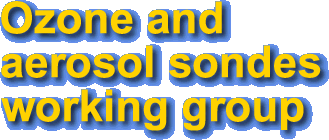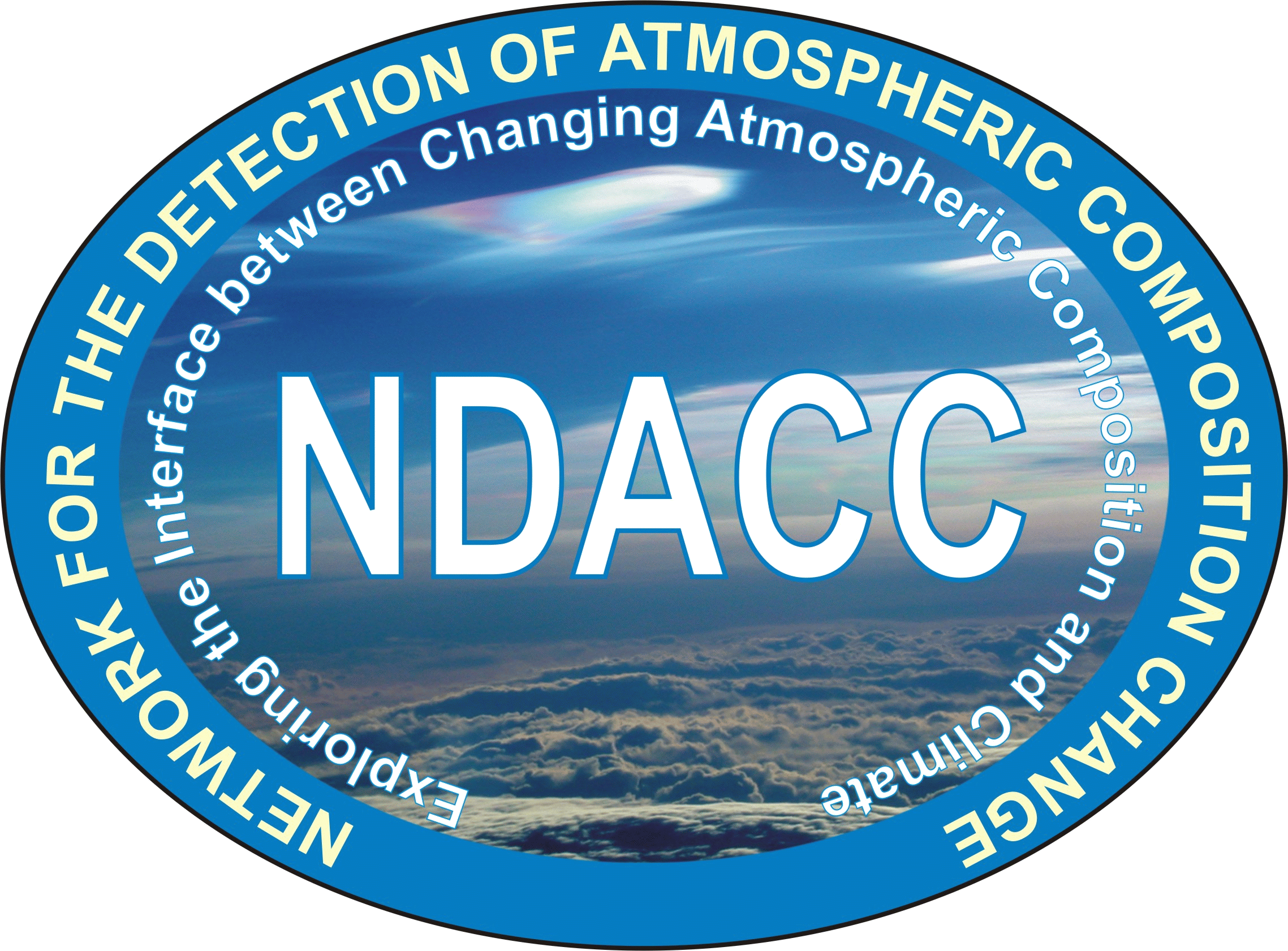

The
ozone and aerosol sonde working group is responsible for
the activities pertaining to ozonesondes and various
aerosol sondes. The working group representatives on the
streering committe are:
Rene Stubi, Senior
Scientist, Federal Office of
Meteorology and Climatology MeteoSwiss. Through 2011
Bryan
Johnson, Global Monitoring Division, National
Oceanic and Atmospheric Administration, Elected 2009
Terry Deshler,
Professor, Department of Atmospheric Science, University
of Wyoming. Through 2009.
---------------------------------- Notes on
Homogenization of ozone sonde data
-------------------------------------------
New ------------
O3S-DQA-Guideline_Summary_OzUncertainty_td.pdf
- April 2013 - Specific guidance in calculating ozone
uncertainty to apply to ozonesonde data as it has been
applied to McMurdo Science Pump and ENSCI ozonesonde data.
For the latter a transfer function was required for
measurements between 1995 and 2005. Examples of ozone data
before and after the corrections and uncertainty
calculations are applied.
2012/2013
- Guide
Lines for Homogenization of Ozone Sonde Data
(Nov. 19, 2012).
Specific
guidelines on transfer functions to convert 1.0% KI
concentration measurements to either 0.5% KI
concentration, or ENSCI measurements to Science Pump
measurements. Section 8.1.2 of the overall guidelines -
Terry Deshler and Rene Stubi.
---------------------------------- Notes on
working group meeting
------------------------------------------------------------
Summary of
conclusions and recommended actions following the NDACC
ozonesonde working group meeting: 5 - 6 February 2009 at the Forschungszentrum
ICG-1/2, Juelich, Germany.
1) Data format recommendations for
submission of ozonesonde data to NDACC, using a NASA
AMES 2160 data format for all new data to be
submitted and, to the extent possible, for old data to be
resubmitted. The latter is desired to maintain consistency
of the data base.
The following documents will guide you
in preparing newly formatted data files:. These files were
developed by Peter von der Gathen, Pavla Skrivankova, and
Terry Deshler. Questions on implementing these
recommendations may be addressed to any of us three.
a) Word
document
describing the independent, dependent, and auxilliary
variables.
b) Example file when the variables
exceed the 132 character limit. Each record requires two
lines.
i) With
explanations
of the records
ii) With
no
explanations - this file passes the data format
checker available below.
c) Example when the
variables do not exceed the 132 character limit, Each
record is on a single line.
i) With
explanations
of the records
ii) With
no
explanations - this file passes the data format
checker available below.
d) Code for data format
checker, requiring the arbirtrary limits on the number
of auxilliary variables and the number of auxilliary
character variables to be increased. This code is
slightly different than what you may already be using
by increasing the limits mentioned. All of this code
is to be run from a unix machine.
i) dataex.f (fortran code), dataex.exe (executable)
ii) Scripts: np_dataex.csh - to run dataex with minimal
prompts
dataex.csh to run dataex with full
prompts
compile_link_dataex.csh to compile and link
dataex.f:
2) The following
actions were proposed at the WG meeting, but no
further progress has been reported:
a)
Experimental comparison of three pump efficiency
measurements (NASA, NOAA, and U. Uwyoming)
b) Completion of dual flight paper involving
measurements in Sodankyla, Payerne, Wallops Island, and
McMurdo.
c)
Additional background current measurements following
the suggestion that background current may not be
characterized properly, particularly in the tropics.
------------------------------------------------End
of
notes on working group meeting
--------------------------------------------------
DAAC Annual Report Form - required from each station once per year, prior to the steering committee meeting. Please email to Terry Deshler and Rene Stubi. The next steering committee meeting is in September 2009.
Standard operating procedures ozonesondesThe standard operating procedures to be used for NDACC ozonesonde operation are those agreed upon after the JOSIE 1996, 1998, and 2000 experiments (Smit et al., 2007) and the BESOS experiment (Deshler et al., 2008). The working draft of the BESOS/JOSIE SOPS is in nearly final form. The recommendation concerning solution strengths is to use the manufacturer's recommended solution strengths, which are 1.0% KI for Science Pump and 0.5% KI for ENSCI. The 0.5% KI solution is to use half of the buffers used for the 1.0% KI.
Current topics of concern:
Data format. The variable options within the NASA-Ames format have allowed individual investigators to use a variety of data formats and to include a variety of ancillary variables. Rene and I feel this variability has led to some difficulties both for the data providers and for the data users. We propose to focus in the coming year on providing some standardized recommendations regarding these points. This will be accomplished by:
1) Summarizing the data formats and ancillary variables currently in use and reported on the NDACC data base.
2) Summarize the format used by the WOUDC
3) Prepare a document to suggest a common data format that could be recommended to the community.
4) Allow NDACC investigators the opportunity to comment on this document.
5) Organize a meeting in earlly 2009 to finalize the working group recommendations.
6) Distribute these recommendations to the community and offer some support for conversion of historical data to the common format.
Homogenization of data sets which were collected using different ozonesonde manufacturers and non standard solution strengths. This may be particularly a problem for investigators which have used 1.0% KI in ENSCI sondes. Preliminary transfer functions have been proposed by Deshler et al. (2008) and Stubi et al. (2008), but additional work is required prior to acceptance of a more final transfer function. Work in this area is anticipated to continue.
Ozonesonde background. There is still uncertainty about which is the best background to use and the best way to determine that background. Usually this background is determined by a filter measurement. Measurements with zero air are preferable particularly in tropical and humid regions; however, this is often not possible. Recent work in this area can be found in Voemel et al. (2009) and Stubi et al. (2008). We encourage additional discussion.
Stations
Station name |
Lat |
Lon |
Principal investigator |
| Alert | 82.50°N |
62.33°W
|
David Tarasick, AES |
| Eureka | 80.05°N |
86.42°W
|
David Tarasick, AES |
| Ny-Ålesund | 78.92°N |
11.93°E
|
Peter von der Gathen, AWI |
| Thule | 76.53°N |
68.74°W
|
Paul Eriksen, DMI |
| Scoresbysund | 70.50°N | 22.00°W | Paul Eriksen, DMI |
| Salekhard | 66.70°N | 66.70°E | Valery Dorokhov, CAO |
| Sodankylä | 67.37°N |
26.65°E
|
Rigel Kivi, FMI |
| Yakutsk | 62.03°N | 129.63°E | Valery Dorokhov, CAO |
| Legionowo | 52.40°N | 20.97°E | Grzegorz Zablocki, Centre of Aerology IMWM |
| De Bilt | 52.10°N |
5.18°E
|
Marc Allaart, KNMI |
| Uccle | 50.8°N |
4.35°E
|
Hugo De Backer, KMI |
| Praha |
50.02°N |
14.45°E
|
Pavla Skrivankova, Czech Hydrometeorological Institute |
| Hohenpeissenberg | 47.80°N |
11.02°E
|
Hans Claude, DWD |
| Payerne | 46.82°N |
6.95°E
|
René Stubi, MeteoSwiss |
| Obs. de Haute Provence | 43.94°N |
5.71°E
|
Sophie Godin-Beekmann and Gérard Ancellet, CNRS |
| Boulder |
40.??°N |
105.??°W
|
Bryan Johnson, NOAA |
| Wallops Island | 37.94°N |
75.46°W
|
Frank Schmidlin, WFF, NASA |
| Izaña | 28.46°N |
16.26°W
|
Emilio Cuevas and Alberto Redondas, INM |
| Hilo | 19.72°N |
155.07°W
|
Bryan Johnson, NOAA |
| Paramaribo | 5.81°N |
55.21°W
|
Marc Allaart, KNMI |
| American
Samoa |
??°N |
??°W
|
Bryan Johnson, NOAA |
| Île de la Réunion | 21.8°S |
55.5°E
|
Françoise Posny, Univ. de la Réunion |
| Lauder | 45.05°S |
169.68°E
|
Greg Bodeker, NIWA |
| Dumont d'Urville | 66.67°S |
140.01°E
|
Marion Marchand, CNRS |
| Neumayer | 70.62°S |
8.37°E
|
Gert König-Langlo, AWI |
| McMurdo | 77.85°S |
166.63°E
|
Terry Deshler, Univ. of Wyoming |
| South Pole | 90.00°S | . | Bryan Johnson, NOAA |
Annual reports from the working group
The ozone and aerosol sonde working group representatives assemble a yearly report on the activities of the measurement sites as well as other relevant activities. These reports are available as PDF documents and can be downloaded by clicking on the links below. From 2001 the reporting takes place via a standardised form (MS Word format) that the station PIs fill in and send to the working group representatives.
2005
Ozonesonde steering committee report to
Ozonesonde PIs.
Letter from Mike Kurylo and Geir Braathen explaining the change of name from NDSC to NDACC
Report presented at the SC meeting in Thun, Switzerland, Sept. 2000 (1853 kBytes)
Report presented at the SC meeting in Sapporo, Japan, Oct. 1999 (2593 kBytes)
Report presented at the SC meeting in St. Denis, France, Dec. 1998 (1031 kBytes)
Report presented at the SC meeting in Ny-Ålesund, Norway, Aug. 1997 (59 kBytes)
First Excel sheet that accompanies the 1997 report (374 kBytes).
Second Excel sheet that accompanies the 1997 report (34 kBytes).
Ozonesonde PI meeting, Potsdam, 1998
A meeting for all the ozonesonde PIs of the NDSC and other stations was hosted by AWI, Potsdam in July 1998. The report from this meeting can be downloaded by clicking on the link below.